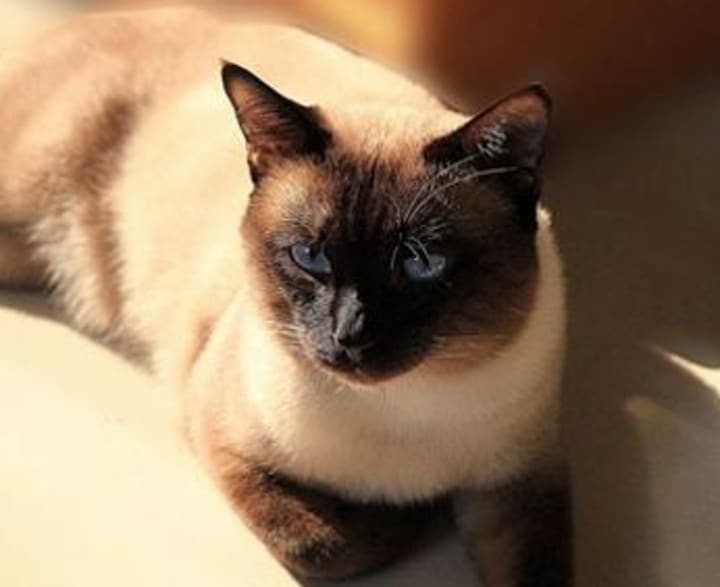Basic feeding of Siamese cats
and living habits

Siamese cats are lively, intelligent, agile, elegant, and uncommon looking by nature. The Siamese cat was one of the first recognized breeds of Oriental Shorthair cats.
The Siamese cat, also known as the Thai cat, was first kept in the Thai royal family and large monasteries and was once a little-known "secret treasure" of the court. The Siamese cat has a long, streamlined body with long, slender limbs, a torso, neck, and tail in balanced proportions. The head is elongated and wedge-shaped, the eyes are blue and almond-shaped, the ears are large and erect, and the nose is high and straight. The coat is short and fine, close to the skin, and shiny. Siamese cats are lively, intelligent, agile, elegant, and uncommon in appearance. The Siamese cat is now the most popular representative of purebred shorthair cats.
The Siamese cat has a long history of over 200 years in Thailand, and in 1884 the British Consul in Bangkok brought back to England one of his gifts, a seal-spotted Siamese cat. In 1920, the Siamese cat was introduced to the United States and then to the rest of the world, where it soon became widely known.
The Siamese cat's coat is uniformly monochromatic but allows for seal-colored spots. There is a small amount of shading on the blue spots. The body coat color should be contrasted with the color of the spots. Smart, lively, agile, curious, and affectionate. Emotional changes, sometimes quiet, sometimes impatient, sometimes modest, sometimes arrogant. He likes freedom, is loyal to his master, and has an elegant temperament.

The Siamese cat has a long, slender, wedge-shaped head. The skull is flat and the top of the head is straight from the tip of the nose when viewed from the side. The face is pointed and V-shaped, and the muzzle is pointed and sharply angled, forming a V from the end of the muzzle to the tips of the ears. The bridge of the nose is high and straight, and from the end of the nose to the tip of the ear is precisely an equilateral triangle. The cheeks are thin and the teeth are clipped. The ears are large, and wide at the base, with pointed, erect ear ends. Eyes: Eyes are medium-sized, almond-shaped, with a dark blue or strong green eye color. The line extending from the inner corner of the eye to the tip of the eye forms a V with the tip of the ear. The heel is slightly convex. The body is medium, and slender, with a typical slim oriental body type. The bones are slender and the muscles are strong. The neck is long, the body is long, and the tail is long and slender. It is cylindrical from the shoulder to the rump. The abdomen is compact but not upwardly retracted. The hips are firmly muscled and as wide as the shoulders. The limbs are long and slender, in harmony with the body shape. The forelimbs are shorter than the hindlimbs. The toes are small and oval. The tail is long and thin, with the tip of the tail slightly curled. The length is equal to the hind limbs. The coat is very short, fine, and close to the body surface. The hair is smooth and shiny. Body hair is uniformly monochromatic, but seal-colored spots are allowed. There is a small amount of shading on the blue spots. The body coat color should be contrasted with the color of the spots. All characteristic spots (snout, extremities, ears, tail) should be of the same color, and there should be no cross-mixing of coat colors or white in the spots. The color of the spots on the characteristic parts should be the following four kinds: seal color spots: and the body is beige. The face, ears, leg halves, feet, and tail are all seal-colored. Blue spots: The body is beige. The face, ears, legs, feet, and tail are blue-gray. Chocolate spots: Ivory body. The face, ears, legs, feet, and tail are chocolate. Lilac spots (lilac spots): The body is white and pinkish-gray. Face, ears, legs, feet, and tail are mauve.
Contraindicated: Body type other than Oriental type, lilac spots, and chocolate spots with shadow color on them. Loose and soft body, sunken or squinting eyes, the inappropriate color of nose glasses and pedipalps, and the inconsistent color of spots as disadvantages. White spots in the spotted part, eye color other than blue and light green, abnormally twisted tail, and no spots are considered inferior.
About the Creator
Diane Dora
man may lead a horse to the water, but he cannot make it drink.






Comments
There are no comments for this story
Be the first to respond and start the conversation.